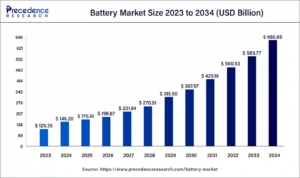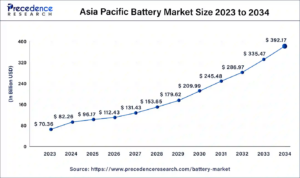The global battery market size is calculated at USD 146.20 billion in 2024 and is expected to hit around USD 680.85 billion by 2034, growing at a solid CAGR of 16.6% from 2024 to 2034.

Battery Market Overview
The battery market refers to the industry involving producing, distributing, and selling batteries or energy storage devices. Batteries are used in a range of applications, such as health instruments, industrial machinery, electric vehicles, and consumer electronics.
AI Revolutionizing the Battery Market
AI is transforming the battery industry by optimizing design, enhancing manufacturing efficiency, and improving energy management. It accelerates material discovery, enables predictive maintenance, and supports sustainability through advanced recycling processes. This innovation boosts performance, reduces costs, and aligns with the growing demand for green energy solutions.
There are two types of batteries disposable and rechargeable. Disposable batteries are used in devices like remote controls and torches, while rechargeable batteries, like alkaline and lithium, are utilized in mobile phones, handheld video game consoles, and digital cameras. The medical sector heavily uses rechargeable lithium-ion and nickel-cadmium batteries in ECG heart monitors. On the other hand, disposable batteries are widely used in consumer electronics.
Battery Market Key Insights
- Asia Pacific dominated the battery market with the largest market share of 56.13% in 2023.
- North America is expected to grow at the fastest CAGR during the forecast period.
- By type, the lead-acid battery segment has contributed the highest market share of 40.8% in 2023.
- By end-use, the automotive sector segment accounted for the biggest market share of 32.4% in 2023.
- By application, the industrial batteries segment has generated the largest market share of 35.9% in 2023.
Regional Analysis of Battery Market:
The Asia Pacific battery market size accounted for USD 82.26 billion in 2024 and is expected to surpass around USD 392.17 billion by 2034, with a solid CAGR of 16.9% from 2024 to 2034.

Asia Pacific dominated the market in 2023. The market in the region is expected to expand rapidly during the forecast period due to a significant reduction in the price of lithium-ion batteries, growing adoption of electric vehicles in countries such as India and China, expansion of the renewable sector, and rising sales of consumer electronics. Government initiatives promoting renewable energy solutions and electric vehicles and rapid industrialization are major factors boosting the demand for batteries in the region. Furthermore, market players are making efforts to capture a large market share.
- In November 2023, BASF, a global producer of battery materials, collaborated with SK On, one of the leading electric vehicle battery cell manufacturers, to assess opportunities within the global lithium-ion battery industry, especially in Asia Pacific and North America.
The market in North America is anticipated to expand at a significant growth rate during the forecast period due to the rising advancements in battery technologies. Moreover, regional market participants are implementing strategic moves through investments, joint ventures, agreements, and partnerships to develop robust battery market in the region.
- In April 2024, Asahi Kasei revealed its plan to build an integrated plant in Ontario, Canada, to produce Hipore wet-process lithium-ion battery separators.
Battery Market Report Coverage:
| Market Size in 2024 | USD 146.20 Billion |
| Market Size by 2034 | USD 680.85 Billion |
| Growth Rate from 2024 to 2034 | CAGR of 16.6% |
| Base Year | 2023 |
| Forecast Year | 2024 to 2034 |
| Largest Market | Asia Pacific |
| Segments Covered | Type, End-Use, Application and Region |
| By Type |
|
| By End-Use |
|
| By Application |
|
| Regions Covered | North America, Europe, Asia-Pacific, Latin America, and Middle East & Africa |
Battery Market Segmental Analysis
Analysis by Type
The lead-acid segment held a large share of the market in 2023 owing to the increasing demand for uninterrupted power supply in industries. Lead-acid batteries play a vital role in a clean and green future by providing approximately 45% of their rechargeable power. These batteries are environmentally sustainable. They also find applications in industries such as transport and communication networks.
Starter batteries, usually found in cars, deliver large bursts of high power. On the other hand, deep cycle lead-acid batteries, usually found on boats or campers, deliver a steady low current for longer periods. All lead batteries serve either starting or deep cycle functions. The only difference is the amount and duration of power delivered.
Analysis by End-Use
The automotive industry segment dominated the market in 2023. The segment is projected to grow significantly during the forecast period due to the increasing adoption of electric vehicles across the globe. The hybridization and electrification of vehicles has increased in recent years.
Furthermore, governments in various countries are providing incentives to promote electric vehicles. The rising adoption of hybrid electric vehicles (HEVs), plug-in hybrid electric vehicle , and EVs boost the demand for advanced batteries, thereby propelling the segment.
Analysis by Application
The industrial battery segment held a major share of the market in 2023 due to the rising demand for energy storage solutions in various industries. Industrial batteries are used as backup power for heavy machinery, electric vehicles, microgrids, and smart grids.
These batteries provide a constant, clean electricity supply in any weather condition. They are also used in hospitals, data centers, and telecommunication facilities. The growing need for reliable power backup solutions in industries is further likely to boost the segment in the coming years.
Battery Market Dynamics
Driver: Improved safety
The battery market is experiencing significant growth due to improved safety measures. Advanced battery technologies have greatly improved the safety of EVs. The most common are lithium-ion batteries, which have a higher energy density and are less dangerous. However, these batteries can be hazardous if treated improperly.
Battery technology has a significant impact on EVs, including increased range, cost reduction, and improvement in safety. These factors make EVs more efficient, viable, and cost-effective for customers.
Restraint: Shortage of raw material
Increasing demand and complex supply chains result in a shortage of raw materials. Essential elements required for battery, mainly cobalt, are sourced from the Republic of Congo. In addition to these challenges, efforts are underway to design and produce low-cobalt or completely cobalt-free batteries.
Better quality assurance is important to track the quality of batteries from manufacturing to production to enhance their safety. This will involve a lot of metrology development, as metal impurities are one of the key factors of battery degradation. There are no effective solutions available so far to detect impurities throughout the entire process, starting from raw materials to final cells.
Opportunity: Advancements in battery technology
Advancements in battery technology create immense opportunities in the market. Battery technology is of utmost importance in relation to modern appliances and vehicles, although its application is somewhat lacking. The problem of lack of range limit and longer charging time is present with its application. Meanwhile, further development of technology for batteries is promising. Solid-state batteries carry a solid electrolyte component. Thus, they have higher power density, charge quickly, and are safe.
Lithium-sulfur batteries have higher energy density, as sulfurs act as anodes instead of a cathode in the battery. Nanostructured batteries enhance performance using nanomaterials, increasing energy density and reducing charge times. With these technologies, great improvements in battery performance, cost, and safety are expected to improve the efficiency and affordability of devices and vehicles.
Battery Market Key Companies
- Delphi Automotive
- The Furukawa Battery Co. Ltd.
- Panasonic Corporation
- Saft Groupe
- Johnson Controls Inc
- Fengfang Co. Ltd
- Chaowei Power Holding Ltd.
- Exide Technologies
- Penn Manufacturing Company Inc
- LG Chem
Recent Developments:
- In August 2024, Ganfeng Lithium, a leading supplier of lithium metal, signed a strategic agreement with Yigit Aku Malzemeleri Nakliyat Turizm Insaat Sanayi ve Ticaret A.S., a Turkey-based company, to jointly expand businesses. Ganfeng Lithium is set to invest US$ 500 million to build a lithium battery project in Turkey with an annual capacity of 5 GWh.
- In August 2024, Gogoro Inc., a Taiwan-based company that specializes in battery-swapping technology, is likely to scale up operations in India after getting the clarification from the government of India about EV subsidies to battery-swapping two-wheelers.
- In August 2024, Natron Energy is set to build the first independent sodium-ion battery gigafactory in Edgecombe County, NC, US. The facility is projected to produce 24GW of batteries annually.
- In August 2024, SS4U, a subsidiary of TSS4U, a Dutch off-grid solar specialist, designed a gel lead-acid battery for residential use. The battery was developed jointly with VDL Groep and includes an integrated charging system that is fully optimized to achieve maximum battery life and performance.
- In April 2024, Amprius Technologies Inc. teamed up with Stafl Systems to provide high-performance battery solutions.
Segments Covered in the Report
By Type
- Flow Battery
- Lead-acid Battery
- Small Sealed Lead-acid Battery
- Nickel-metal Hybrid Battery
- Zinc-manganese Dioxide Battery
- Sodium-sulfur Battery
- Nickel-ion Battery
- Lithium-ion Battery
- Others
By End-Use
- Military & Defense
- Energy Storage
- Electronics
- Automobile Aerospace
- Others
By Application
- Portable Batteries
- Industrial Batteries
- Automotive Batteries
By Region
- North America
- U.S.
- Canada
- Europe
- Germany
- UK
- France
- Italy
- Spain
- Sweden
- Denmark
- Norway
- Asia Pacific
- China
- Japan
- India
- South Korea
- Thailand
- Latin America
- Brazil
- Mexico
- Argentina
- Middle East and Africa (MEA)
- South Africa
- UAE
- Saudi Arabia
- Kuwait







